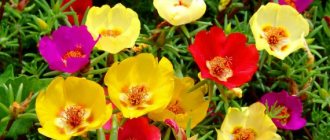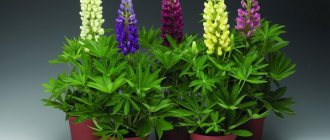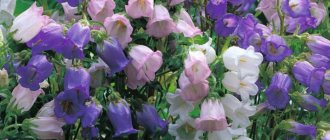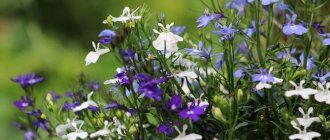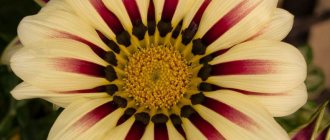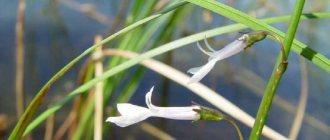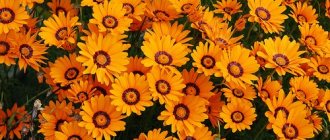Planting and caring for perennial alpine astramits requires classical knowledge of this genus, which has about 250 different varieties. In their natural habitat, perennials are widespread throughout the northern hemisphere. Plants are perfectly adapted to harsh living conditions. The culture is frost-, cold-, and stress-resistant and easily tolerates drought. Thanks to their unique qualities, alpine ground cover perennial asters are very popular among landscape designers.
Alpine aster is a unique stress-resistant ornamental plant cultivated by humans since the mid-16th century.
Description and characteristics
An amazing flower - the alpine aster is able to bloom in the same place for about 7 years without interruption. The period of intensive budding occurs in 3-4 years. The plant is characterized by the following external signs:
- stems are strong, erect, pubescent;
- stem height up to 40-50 cm;
- leaves are spatulate, ovate or lanceolate (depending on the variety), pubescent;
- inflorescences - single baskets with reed petals;
- diameter of inflorescences from 3 to 8 cm;
- the color of the inflorescences is various shades of white, red, blue, pink, blue, violet.
Every year, the root system of a perennial crop spreads a certain distance along a horizontal plane.
The photo shows an alpine perennial aster that can delight with the abundant flowering of chamomile-like inflorescences from May to September.
Alpine aster is a unique stress-resistant ornamental plant cultivated by humans since the mid-16th century.
Landing
Before planting an alpine aster, it is important to carefully and wisely select a location. The following tips can help with this:
- Although the aster prefers light-loving places, open sunlight can harm the plant. That is why it is better to stay in partial shade.
- The landing site must be protected from the wind.
- The shrub should not be in soil with constant moisture, as this can lead to rotting of the root system.
- It is necessary to drain the soil by adding sand to the hole.
Varieties of alpine perennial aster
One of the most popular herbaceous plants for open ground is the alpine aster. Various varieties are popular among landscape designers, florists and gardeners. Each of them is naturally endowed with original external parameters.
Different varieties of alpine perennial asters differ not only in their color diversity, but also in the shape of their inflorescences
Stained glass
The Vitrazh variety belongs to cold-resistant and frost-resistant crops. The height of the bushes is up to 50 cm. The leaves do not die off in the winter. Inflorescences are in the form of snow-white baskets of a single type, up to 5 cm in diameter.
Stained glass is used to form borders, the front line of mixborders, alpine slides
White Alps
The perennial alpine aster White Alps is characterized by a bush height of up to 30 cm. White chamomile-shaped flowers with yellow centers attract with abundant flowering from July to September.
The compact variety White Alps fits harmoniously into flowerbeds, mixborders, alpine slides, and is used for cutting
Blue
The large-flowered alpine perennial aster Blue (Blue) has a stem height of up to 50 cm. The flowering of numerous inflorescences is impressive with a blue-blue hue. The diameter of the Blue inflorescences is 6-8 cm. Each bush of the Blue Alpine aster is a separate bouquet, a complete composition.
The long-blooming variety of perennial aster Blue is one of the most popular and unpretentious varieties for border decoration.
Pink
Alpine Pink Aster is a stunning, popular ground cover variety that blooms early. The variety looks good in the foreground in prefabricated seasonal mixborders, complex figures with periodic color changes. The color of the inflorescences is pink, the diameter is up to 4 cm, the height of the bush is 25-30 cm.
Read more Sowing aster in open ground in spring: when to sow, care, photo
The flowering of the Pink Alpine star lasts from May to July; with the timely removal of faded inflorescences, the flowering period of the crop can be extended
Happy End variety
The winter-hardy variety of perennial aster Happy End is characterized by a height of up to 25-30 cm. The flowers are dark pink with a purple tint, a yellow center, and up to 4 mm in diameter. Happy End blooms in May-June.
Happy End asters are perfect for landscaping lawns, flower beds, mixed borders, borders
Illyria
Alpine aster Illyria compares favorably with other perennials with a diverse palette of shades of white, lilac, and blue. The height of the bushes is up to 20 cm, the diameter of the inflorescences is up to 5 cm.
The plant is used to decorate rocky alpine hills and multi-colored borders
Alpine blend
Perennial aster Alpine mixture is a popular and sought-after variety. The height of the stems is up to 30 cm, the diameter of chamomile inflorescences is up to 4 cm.
The culture is used for cutting, design of prefabricated flower beds
Sabina
The perennial Sabina belongs to the terry alpine varieties. The diameter of the original double purple inflorescences is up to 4 cm. The height of the Sabine bush is up to 20 cm.
The terry perennial aster Sabina looks original on alpine hills, in the foreground of flower beds
Popular varieties with photos
The most common varieties of alpine aster are:
- Albus;
- Gloria;
- Goliath;
- Rosea;
- Ruber.
When to plant alpine aster
The most popular method of propagating perennials is by seeds. Alpine aster is grown from seeds using seedlings and non-seedling methods (sowing in open ground).
Alpine aster seeds are sown for seedlings at the end of February or early March. Alpine aster seedlings are transferred to open ground at the end of May or early June after a consistently warm average daily temperature has been established.
In the southern regions, seeds are sown in open ground at the beginning of May or at the end of November before winter.
Plants grown from seeds sown in open ground begin to bloom within a year
Cuttings.
Reproduction by cuttings is the most optimal option for breeding aster if you want the young to inherit all the maternal characteristics. This method is available even to beginners, if, of course, you follow some rules.
Only healthy and strong cuttings need to be cut.
When cutting young shoots into pieces, make sure that each petiole has 3 leaves.
Sections must be treated with a preparation to stimulate root formation, for example, succinic acid.
The petioles are planted in a soil substrate that includes turf, peat and sand.
In order for the petioles to take root faster, they must be covered with film material.
Soil moistening is carried out moderately; excessive drying and excess moisture should not be allowed.
The planted plants are ventilated daily - the film material is temporarily opened.
14-21 days after rooting of the cuttings, the film is removed.
Adapted bushes are transplanted into the ground in the last days of summer or in the first autumn month.
Sowing seeds and caring for seedlings
Experienced gardeners distinguish two main methods for sowing seedlings of perennial alpine aster:
- classical sowing by deepening seeds treated with growth stimulants and disinfecting solutions;
- special sowing of alpine aster seeds in boiling water.
Growing alpine aster seedlings is a painstaking process, since the seed material does not have a high degree of germination.
Growing aster seedlings at home allows you to get beautifully flowering plants for decorating your local area.
Preparing containers and soil for growing seedlings
As a planting container, choose any container with sufficient drainage from broken bricks or expanded clay.
The soil should be loose and nutritious. This could be a universal mixture:
- garden soil;
- sand;
- peat;
- humus.
The soil is spilled with a solution of potassium permanganate for disinfection.
The seeds of perennial alpine asters have poor germination, so they are prepared for planting with growth stimulants and disinfected in a solution of potassium permanganate.
To prevent infection of seedlings with fungal infections, seeds of perennial alpine asters are treated with a 1.5% solution of potassium permanganate
Classic method of sowing seedlings
When sowing classically in containers, furrows are made up to 1-1.5 cm deep. The seeds are buried in the prepared soil mixture. Planting pattern:
- distance between rows - up to 8 cm;
- the distance between the seeds is up to 5 cm.
Read more Planting aster for seedlings: when and how to sow correctly, photo
The seeds are sprinkled with earth on top, and the container with the seeds is covered with plastic film or glass to create a greenhouse effect.
Comfortable microclimate for crops - sufficient level of illumination and air temperature not lower than +20⁰С
Special method of sowing seedlings
A special method for obtaining seedlings is to treat the crops with boiling water. As with classical planting, the prepared seeds are placed in a container with soil mixture, following the universal scheme. After distributing the planting material on the soil surface, the crops are spilled with boiling water, the container is covered with glass or film to ensure a greenhouse effect.
Seedling care
The container with the crops is placed in a warm place, on the south, well-lit side at room temperature not lower than +18-20⁰С. Watering is done as needed. After the emergence of seedlings, the shelter is removed and the temperature is lowered to +16-18⁰С. When 3-4 main leaves are formed, the seedlings are picked. The sprouts of perennial asters are hardened off 2 weeks before transplanting into open ground.
The seedlings should be watered in a timely manner, avoiding the formation of a crust on the soil surface.
Beautiful varieties and hybrids
The most beautiful hybrid of this flower is considered to be the alpine aster Stained Glass. This is a frost-resistant perennial with decorative snow-white flowers, which grows quite quickly and blooms profusely.
In addition to this hybrid, flower growers also grow other species - Glory, Alba, Goliath, Superbus, Ruber, Pink aster. The care for these plants and the conditions for their maintenance are almost the same.
The perennial alpine aster is an unpretentious flower. Among all varieties there are herbaceous and semi-shrub forms. Due to its unpretentiousness and decorative appearance, this plant is often used as a decoration for rock gardens or rocky hills. Asters are also planted in front gardens, flower beds, and borders in combination with other perennial garden flowers. This flower goes well with carnation, iberis and yarrow.
In addition to its decorative qualities, this plant has healing properties. Infusions are prepared from alpine aster flowers, which help with tuberculosis, scrofula and gastrointestinal disorders.
Planting in open ground
Alpine aster seedlings are planted in open ground at the end of May or at the beginning of June when stable air and soil temperatures have been established during the day.
Since asters are light-loving crops, when choosing a place to place seedlings, it is necessary to give preference to open, well-lit areas without drafts.
The soil is dug up, fed with superphosphate and dolomite flour, peat, sand and humus are added.
Seedlings are placed in shallow holes along with a ball of earth, following the planting pattern:
- distance between bushes - up to 20 cm;
- the distance between rows is up to 40 cm.
After the seedlings are buried, grooves are made between the rows for watering
Growing and care in open ground
The perennial alpine aster is an unpretentious ornamental plant that requires minimal care in the open ground:
- moderate watering without waterlogging with soft, settled water;
- hilling bushes to strengthen the root system;
- loosening the soil to prevent the formation of a crust on the surface of the earth;
- mulching with pine needles or sawdust to block weed growth and retain moisture;
- fertilizing with potassium and phosphorus fertilizers in early spring after transplanting seedlings into open ground, mullein solution in June, wood ash in autumn;
- removal of weeds to prevent infection by fungal diseases and pests;
- removing faded inflorescences to ensure an aesthetic appearance;
- preparing for winter, trimming dried leaves and stems to the root collar, covering with dry leaves.
removing faded flowers stimulates the formation of new buds
How to grow flowers correctly.
The variety is very unpretentious and is cultivated outdoors. But in order for flowering to be long and widespread, favorable conditions for the life of the Alpine aster are necessary.
If the place is well lit, then the bushes will grow and acquire a dense, voluminous appearance.
If you lay a drainage layer at the planting site, this will increase the adaptation of flowers to new conditions, therefore, more plants will take root.
When plants bloom, they require a lot of watering.
Some varieties, especially tall ones, need to be fed regularly.
When frosts occur in the autumn season, the bush is pruned to the level of the root collar.
When pruning is done in the spring, frozen branches should be removed at the same time.
When parts of the root system are exposed, the asters are transplanted or sprinkled with soil.
Varieties that quickly degenerate are dispersed, their healthy fragments separated.
In the southern and middle latitudes there is no need to cover asters for the winter; in the north, shelter is provided with spruce branches or dry moss.
Reproduction methods
There are several ways to propagate the alpine perennial aster:
- seed (seedlings and non-seedlings);
- vegetative (by dividing the bush and cuttings).
Read more How to treat asters from diseases and pests
Dividing the bush can be done throughout the summer season. Experienced gardeners recommend dividing the root system and replanting the mother bush at least once every 7 years.
Transplanting plants when dividing a bush stimulates flowering and improves the decorative properties of the crop
Dividing the bush
When dividing the bush, the mother plant is completely dug out of the ground, all dry, rotten stems, roots, and shoots are removed. The sections are treated with wood ash. The plots are planted in new places, in prepared and fertilized soil.
The aster can be planted in its original place after 5 years
Cuttings
Cuttings of alpine perennial asters are carried out in the spring. The apical branches with three viable leaves are cut from strong shoots. The cuttings are kept in root formation stimulants and planted in the prepared soil mixture:
- sand;
- peat;
- turf land.
The cuttings are covered with film, periodically ventilated and watered. They are transplanted to a permanent place in open ground in September.
Cuttings allow you to completely preserve varietal characteristics
Possible diseases
Diseases avoid the plant with careful care. However, if it rains frequently in the summer and the planting site remains damp, the plant will develop powdery mildew. The disease has a fungal basis. Fungal spores affect the entire flower - from rhizome to bud. The problem can be easily avoided with the help of Topaz and Fundazol. In the autumn, most gardeners treat plants with copper sulfate, this protects the flower from late blight disease.
Asters planted in damp places become ill with fusarium, which affects the root system. The plant becomes brown, the leaves turn yellow and wither. Plants affected by the fungus should be promptly eliminated to prevent the disease from spreading throughout the area.
Jaundice, sclerotinia, pathological rust, and rhizoctonia are considered dangerous diseases. However, these diseases are less common. To increase the resistance of perennial plants to diseases, gardeners treat the area with zircon.
When do alpine aster seedlings bloom?
Alpine aster seedlings produce flower stalks the following year after rooting in open ground. If it produces buds in the fall of the year the seedlings are planted, they should be cut off. Young plants that bloom in autumn may not survive winter well.
Most varieties of alpine perennial aster are characterized by a flowering period of May-July
Aftercare
Regardless of the chosen variety, Alpine aster does not require special care. To obtain lush, abundant flowering, it is important to comply with several requirements:
Watering
Aster is considered a moisture-loving plant. However, you should remember: to avoid moisture accumulation at the roots, the soil must have time to dry out between waterings. During heavy rains, watering should be stopped until the soil is completely dry.
Top dressing
It should be carried out in early spring. This will help the plant wake up and replenish the nutrients lost during the winter. One of the feeding options is a fertilizer from a mixture of 6 grams of nitrogen, 4 grams of phosphorus and 4 grams of potassium, calculated per 1 square meter.
Diseases and pests
Perennial asters are susceptible to infection by fungal pathogens: powdery mildew, fusarium, and blackleg. Diseases affect the root system, stems, foliage, and inflorescences.
When the first signs of disease are detected, the affected plants should be treated with solutions of modern fungicides (Topaz, Fitosporin)
Young shoots and leaves, unopened buds of asters are attacked by slugs, aphids, spider mites, cutworms if proper care is not taken. Modern insecticides (Karbofos, Actellik) help get rid of pests for a long time.
Timely removal of weeds allows you to resist attacks from parasitic insects
Prevention of diseases and harmful insects.
The variety has a high immunity to common diseases, but if you care for the flowers poorly, they can get powdery mildew or fusarium. When the first symptoms of the disease appear, it is necessary to remove the infected fragments and destroy them; the bushes are treated with anti-fungal medications or Bordeaux mixture.
Flowers can also be attacked by harmful insects, for example, spider mites, caterpillars, and slugs. Prevention and treatment are carried out with various drugs or folk remedies, for example, ash or soap solution. The best preventive measure is to provide favorable conditions for the life of flowers. Then you won't have to treat it.
Application in landscape design
Perennial alpine asters are a magnificent decoration of the local area, park and garden areas. Plants are harmoniously combined and coexist with various ornamental crops:
- with non-flowering or inexpressively flowering ground cover plants (stachys, sedum);
- with flowering crops of different flowering periods (daffodils, tulips, chrysanthemums, marigolds, geraniums);
- low-growing varieties are especially relevant at different elevation levels of alpine hills;
- close plantings of alpine varieties of varying heights look beautiful next to phlox, daylilies, astilbe in original mixborders;
- in ridges along houses and various architectural forms;
- for decorating borders.
Chrysanthemums are excellent “neighbors” for perennial asters; in July they pick up the “relay” of flowering



